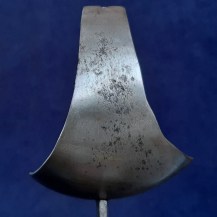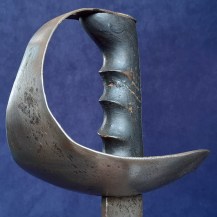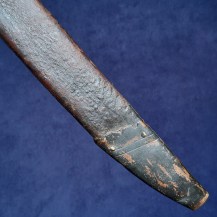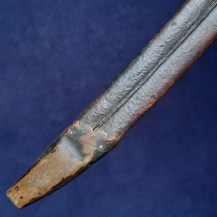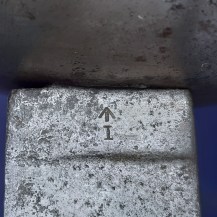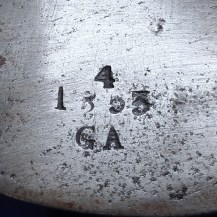British 1844 'Deakin' or 'Dundas' Variant Cutlass, Indian Service Marks
Curved unfullered spear-pointed blade, steel basket hilt, smooth cast iron grip with finger grooves, painted black. Thin flat teardrop-shaped pommel cap. No washer. Black leather scabbard with copper frog stud and brass chape piece, the chape piece painted black. Blade 29 inches in length (73.7cm), 1 3/8 inches wide at the shoulder (3.6cm), the cutlass 34 inches overall (86.4cm).
The blade is stamped at the ricasso on one side with a broad arrow above ‘I’, which is an Indian government stores mark. The spine of the blade is stamped with ‘1844’, presumably the production date. The outside of the hilt is stamped with ‘4 1853 GA’. 1853 is probably the issue date, GA probably indicates a unit, although I am unsure what unit this may be. The hilt is stamped next to the knot slit with ‘40’, probably a rack number.
The leather of the scabbard is stamped on the rear side next to the seam with ‘BO’ and a broad arrow, the ownership stamp of the (British) Board of Ordnance, as well as ‘1844’, again presumably the production date.
This cutlass is sometimes referred to as the ‘Deakin patent’ model, although only a few carry a maker’s mark. The September 2018 issue of the Naval Historical Review (published by the Naval Historical Society of Australia) does illustrate an example marked to Deakin, but there is also an example in the Royal Armouries (Item IX.5449) marked to Hadley. I have not yet seen any material proving that this was a Deakin design.
It is also sometimes called the ‘Dundas’ cutlass, although this seems to derive solely from the finger grooves on its grip, which superficially resemble the grooves found on the circa 1845 Royal Artillery ‘Dundas’ sidearm. Examples of the cutlass have been seen with brass and steel grips, and both straight and curved blades (steel and curved being more common), although the form of the hilt and grip is reasonably consistent.
Lists of standard Royal Navy cutlasses do not include it, although a few sources note it as an ‘experimental’ type. There do not appear to be any records of it being formally designed and commissioned by the Board of Ordnance, even as an experiment, but examples like this one exist which have clear Board of Ordnance markings and other British government ownership and issue stamps, strongly suggesting that it did see official usage with the Royal Navy in some capacity - perhaps a commercial type purchased off the market to supplement official production?
Its blade is clearly made to the same specification as the official 1845 Pattern cutlass, with matching length, curvature etc. I have not seen any other example with a manufacture date – this one being made in 1844 is interesting as the first large-scale orders of the 1845 Pattern was also in production during that year – the work was parcelled out to many different manufacturers who evidently used the design for their own non-standard versions.
The blade has some pitting overall, diminishing towards the point. Some pitting impacts the edge at the foible but there are no nicks. The tip has fractionally worn (<1mm). The outside of the guard seems to have been roughly cleaned/polished in the past, leaving polishing marks. Some deeper pitting remains, as well as patination in places. The inside of the guard has dark even patination, pitting in places, and some traces of black paint near the grip (runoff from painting?) The grip retains much of its original black paint with some rubbing at the backstrap exposing patinated iron. There is a crack running the full circumference of the grip, which I assume runs all the way through dividing the grip into two pieces. However, despite this the grip is completely solid and firm in the hand with no movement whatsoever.
The leather of the scabbard has some rubbing and knocks but remains strong with no losses to its stitching (possibly a repair/reinforcement to the stitching at the throat end, although this does not look modern). Some patination to the copper stud. The brass chape piece has some light dents and some rubbing & flaking to its black paint revealing patinated brass, more extensive on the rear side. Assuming there was a leather washer, this has been lost.





